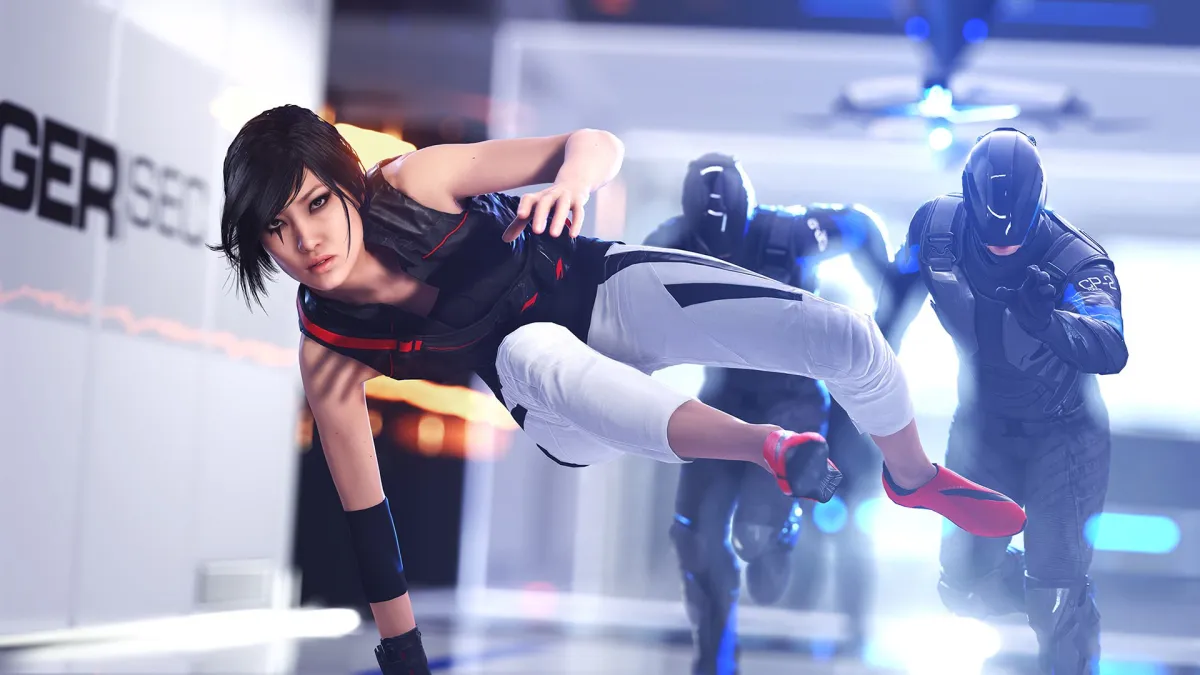Have faith, this game runs great
Mirror’s Edge is my jam. It was one of the first Xbox 360 games I really fell in love with, and since then I’ve clocked hundreds of hours across the 360 and the PC versions speedrunning, doing time trials, trying out mods, and generally having a grand ol’ time being super-agile runner Faith.
The fact we’re even at the point where we’re all talking about a second Mirror’s Edge game fills me with excitement. I’ve been on shaky ground with Mirror’s Edge Catalyst ever since I originally played it at EGX, and so I’m happy to report that not only is the PC port of it fabulous, but the game itself easily stands up to its predecessor as an incredibly enjoyable experience.

Rig: Intel i7-4790k 4GHz 4-core processor, 16GB of RAM (2x Corsair Vengeance 8GB DDR3), GTX 980.
Tested with existing drivers (368.22). Windows 10 Pro 64-bit. Frame rate measured with Nvidia GeForce Experience. Game played at the automatic preset (between high and ultra) on 1920×1080.
The PC settings are fairly standard for a good PC port. While the graphics options aren’t exactly The Division levels of extensive, it includes everything you’d want and expect. There’s anti-aliasing, v-sync, a full FOV slider, borderless windowed mode, and even two different types of ambient occlusion (horizon-based and screen space).
Catalyst isn’t a complicated game control-wise, yet it still offers complete key rebinding and three distinct gamepad configurations: default, alternative, and a left-handed/southpaw mode. There’re a few gameplay options too, such as how runner’s vision (basically quest waypoints) function and which UI elements are displayed.
All in all, while it doesn’t feature a glut of high-end options like chromatic aberration, depth-of-field, or freakin’ Razer Chroma integration, Catalyst’s options menu is by no means bare-bones. There’s definitely enough there to satisfy all but the pickiest of players.
When it comes to performance, Catalyst is on the whole fantastic, bar a few hitches here and there. I played on the automatic config, which for my system was somewhere between the “high” and “ultra” presets, and even then enjoyed an almost constant 60FPS.
90% of the time the game runs incredibly smoothly. However there are a few areas, particularly when enemies get involved, that the frame rate can drop down to about 50, which isn’t the worst thing in the world, but still noticeable. The dips seem linked to specific, less optimised areas rather than being a pervasive issue, so its impact on the gameplay (where you’re rapidly moving through areas anyway) is minimal. No matter the size or detail of the area, my frame rate never dropped below 50 (outside of pre-rendered cutscenes, which are locked at 30).
The game’s an absolute beaut’, boasting classy lighting effects and high-quality textures right the way across its massive open world. It’s not perfect, though, as I noticed a few minor visual glitches and the odd overlapping texture, particularly during in-engine cutscenes. There was a certain amount of detail pop-in that could be distracting at times too, particularly with distant assets, such as buildings, that looked incredibly low-res and undetailed. That’s kind of disappointing after working your way up a massive tower to look out across the city.
All in all, though, Mirror’s Edge Catalyst PC port, while not entirely flawless, is definitely one of the better ones out there. It runs well, looks great, and has enough graphics options for those who like to tinker. Seeing as the game has very few loading screens for such a vast and detailed world, it’s is a major accomplishment and possibly the best use of the Frostbyte engine we’ve seen yet.

While it’s not everything I’d have wanted from a sequel, Catalyst certainly lives up to the Mirror’s Edge name.
Bits of it could have used some refinement. The story (much like the original) is vaguely dystopic guff, filled with flat and unlikable characters and too many plot twists for any of them to have any impact. The open world is squeezed through one building in the middle like a bow-tie, and so there are small sections of the map that you keep having to return to over and over again no matter where you want to go, which can get repetitive. The combat is definitely an improvement from the original, but is still unwieldy and could have been improved by using Sleeping Dogs-style environmental attacks, rather than just kicking guards into walls.
But those problems don’t subtract from Catalyst’s bloody brilliant core: the running. It’s less mechanically involved than the first game, but the open world means there are fewer times where you’re arbitrarily stopped. That exciting feeling of pure flow from the first game is spread out over this sprawling city, and it often feels even better than anything we saw in 2008.

There’s no more hours of crawling through winding air vents, lifts are virtually non-existent, and there’s no ridiculously long segments set in the back of a small van. Your entire time is spent flowing through the world at high speed, and there’s enough variation in the environment to keep things exciting. It took me about 13 minutes to run from one end of the city to the other, and for that entire time, I didn’t stop or slow down: something its predecessor never quite managed thanks to frequent hidden loading screens.
The missions are exciting, there’s a hell of a lot of side-content, and most importantly just traversing that world is fun as hell. Mirror’s Edge Catalyst might not have the long-term speedrunning appeal of the original, but in other ways it maybe even surpasses the original for its sense of flow and progression.
At its heart, Mirror’s Edge has always been a simple game. I was originally worried that lumping a load of superfluous side missions and open world nonsense would dilute that, but, if anything, it just gives more of what I loved about the original: dizzying heights and a lot of speed.
[This PC Port Report is based on a retail build of the game provided by the publisher.]













Published: Jun 6, 2016 11:01 am